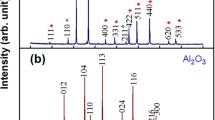Abstract
The development of denser and higher powered integrated circuits has led to a corresponding demand on the performance of dielectric substrates. This paper reports on the fabrication and properties of an AlN multilayered sandwich substrate comprising porous tape-cast layers sandwiched between nonporous layers. Tapes were produced by nonaqueous tape casting, with the porous tapes produced using polymer microspheres as sacrificial molds. Starting from initially Al2O3-rich tapes, the multilayered sandwich substrates were reaction sintered to produce AlN substrates. No interface cracking or delamination was observed in the substrates as a result of the processing. The added porosity resulted in a decrease in the substrate dielectric constant in correspondence to porosity volume. Mechanical strength of the sandwich substrates was improved over that of nonsandwich porous substrates, while substrates having noninterconnected pores showing higher mechanical strength than substrates with connected pores. Substrates with more than 2% porosity showed porosity-dependent thermal conductivity values, while thermal conductivity of substrates with less than 2% porosity was dependent on grain boundary effects. Thermal expansion coefficient of the substrates was unaffected by porosity levels.
Similar content being viewed by others
References
Semiconductor Industry Association, International Technology Roadmap for semiconductors, ITRS Report 1999 Edition (1999).
R.C. Buchanan, Ceramic Materials for Electronics: Processing, Properties and Applications (Marcell Decker Inc., New York, 1986).
J.S. Reed, Principles of Ceramics Processing (John Wiley & Sons, New York, 1994).
B. Schwartz, Am. Ceram. Soc. Bull. 65(7), 1032–1035 (1986).
T. Chartier and E. Streicher, J. Eur. Ceram. Soc. 9, 231–242 (1992).
J.M. Haussone, Mater. Manuf. Processes 10(4), 717–755 (1995).
D. Wirth, Engineered Materials Handbook (ASTM, West Con-shohocken, PA, 1991), Vol. 4 pp. 1107–1111.
J.P. Disson and R. Bachelard, Ind. Ceram. 896(9), 602–606.
W.T. Shugg, Handbook of Electrical and Electronic Insulating Materials, 2nd ed. (IEEE, Piscataway, NJ, 1995).
A.A. Mohammed and S.J. Corbert, Proc. Int. Symp. Microelec-tron. 218–224 (1985).
G. Selvaduray and L. Sheet, Mater. Sci. Technol. 9, 463–473 (1993).
F. Boey, L. Cao, K.A. Khor, and A.I.Y. Tok. Acta Mater. (in press).
F.Y.C. Boey, X.L. Song, Z. Gu, and A.I.Y. Tok, J. Mater. Process. Technol. 89–90, 478–480 (1999).
D.W. Kellerman, in Hollow and Solid Spheres and Microspheres: Science and Technology Associated with Their Fabrication and Application (Mat. Res. Soc. Symp. Proc. 372, Pittsburgh, PA, 1995). pp. 239–245.
E.H. Kraft, Materials and Designs for Advanced MIC Packages (American Institute of Physics, Melville, NY, 1986), pp. 255–266.
A.I.Y. Tok, F.Y.C. Boey, and W.J. Clegg, J. Mat. Res. (2001, in press).
G. Carprino and A. Langella, J. Comp. Mater. 34(9), 791–814 (2000).
D.J. Bakos and G.C. Papanicolaou, Comp. Sci. Technol. 49, 35–43 (1993).
B. Lamy and E. Dixneuf, J. Mater. Sci. Lett. 18, 607–608 (1999).
Y. Shenbar, Y. Prostig and E. Altus, Comp. Struct. 35, 143–152 (1995).
G. Caprino and R. Teti, Sandwich Structures Handbook (Prato Publications, Prato, Italy, 1989).
M. Vincenzo, P. Sglavo, P. Bosceri, E. Trentini, and M. Ceschini, J. Am. Ceram. Soc. 82(8), 2269–2272 (1999).
Y. Huang, Development of hollow polymer microspheres, Master of Engineering Thesis, Nanyang Technological University, Singapore (1999).
A.I.Y. Tok, F.Y.C. Boey, and Y.C. Lam, Mater. Sci. Eng. A280, 282–288 (2000).
A.I.Y. Tok, F.Y.C. Boey, and K.A. Khor, J. Mater. Process. Tech-nol. 89–90, 508–512 (1999).
S.C. Joshi, Y.C. Lam, F.Y.C. Boey, and A.I.Y. Tok, J. Mater. Process. Technol. (2001).
W.C. Mackrodt, in Advances in Ceramics, edited by C.R.A. Cadow and E.C. Mackrodt (American Ceramic Society, Westerville, OH, 1987) pp. 293–306.
J.H. Enloe, R.W. Rice, J.W. Lau, R. Kumar, and S.Y. Lee, J. Am. Ceram. Soc. 74(9), 2214–2219 (1991).
N. Kuramoto, H. Taniguchi and I. Aso, Am. Ceram. Soc. Bull. 68(4), 833–837 (1989).
D. Hill and T.W. Clyne, An Introduction to Composite Materials, 2nd ed. (Cambridge University Press, Cambridge, United Kingdom, 1996).
E. Ryahkewich, J. Am. Ceram. Soc. 36(2), 65–68 (1953).
W. Duckworth, J. Am. Ceram. Soc. 36(2), 69 (1953).
Author information
Authors and Affiliations
Rights and permissions
About this article
Cite this article
Boey, F.Y.C., Tok, A.I.Y., Long, Y. et al. Properties of Porous AlN Multilayered Ceramic Sandwich Substrates. Journal of Materials Research 17, 1061–1068 (2002). https://doi.org/10.1557/JMR.2002.0157
Received:
Accepted:
Published:
Issue Date:
DOI: https://doi.org/10.1557/JMR.2002.0157




